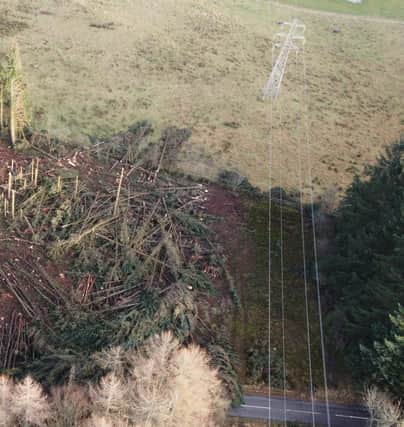Building power line resilience


Thousands of homes were left without power last winter when unprecedented storms flattened swathes of forestry and caused a major failure of power supplies.
Despite a Herculean effort to clear windblown trees and restore the power network, some homes were without electricity for a week or more. It will take several more years to fully clear the vast amount of storm damaged trees across our forests.
Advertisement
Hide AdAdvertisement
Hide AdIn a joint effort across the north of Scotland, FLS, SSEN Transmission and SSEN Distribution are working together to reduce the likelihood of such power cuts in future.
David Leven, East Region Manager for FLS, said “Everyone will remember the severity of last year’s storms and while the power network has been restored, the damage to our forests is still evident in many places.
“One of the hidden impacts of this damage is that there are some trees in some locations that are now unstable and more vulnerable to being blown down by weaker winds than we saw last year.
“In addition to clearing trees that have been blown down, we are also working with SSEN to identify where trees have been destabilised along wayleaves so that we can fell those trees and remove the risk of them causing more damage.”
Forests are designed in such a way that these wayleave edges are largely protected from wind damage. However, catastrophic failure in the face of exceptional storm winds is both difficult to predict and to avoid.
John Sharpe, SSEN Distribution’s Tree-cutting Operations Manager, said: “Last winter, Storms Arwen, Malik and Corrie presented unprecedented challenges for the North of Scotland, with significant disruption experienced due to fallen trees and windborne debris striking overhead power lines.
“This year, we’re investing above and beyond the committed £100m investment in our regions to boost the resilience of our network, with £2m of additional, targeted investment in tree cutting, inspecting around 2,000km of network and clearing trees and vegetation from approximately 600km of power line between now and Spring 2023.
“Working closely with Forestry and Land Scotland to complete this essential resilience investment is critical, with our 35-tonne live line harvester allowing many tree feeling projects to be carried out safely without the need to temporarily turn off power supplies to our customers.”
Advertisement
Hide AdAdvertisement
Hide AdMartin Sangster, SSEN Transmission Vegetation Management Operations Manager, said: “As part of our ongoing maintenance of our electricity network, we undertake extensive tree cutting resilience activities to reduce the risks of tree related faults. As part of this year’s resilience programme we have been working with Forestry Land Scotland to address a one kilometre section of our network which crosses through their woodland areas in the north east of Scotland, one of the hardest hit areas during last year’s storms.”